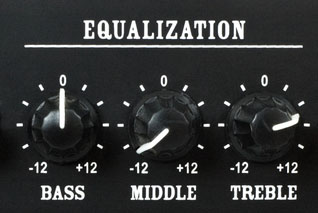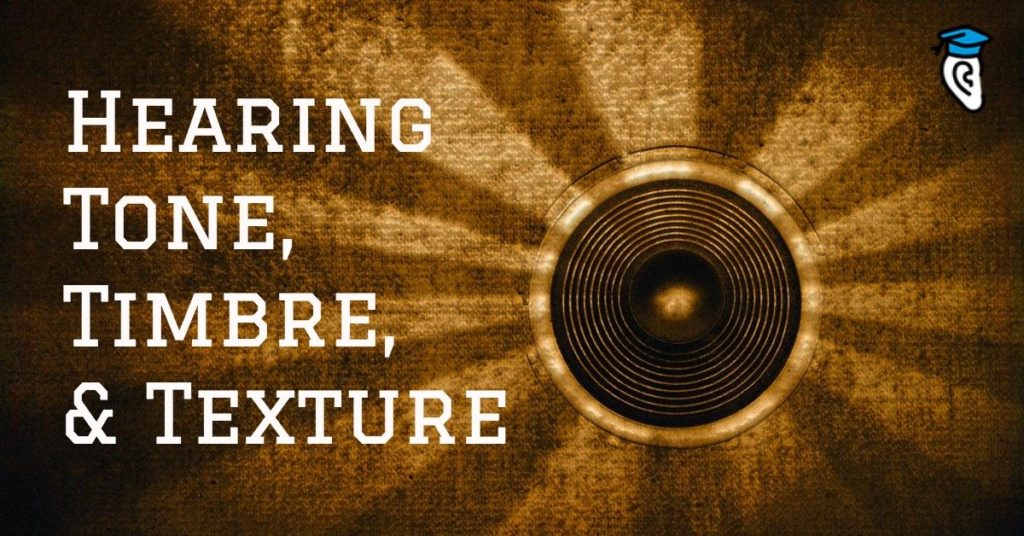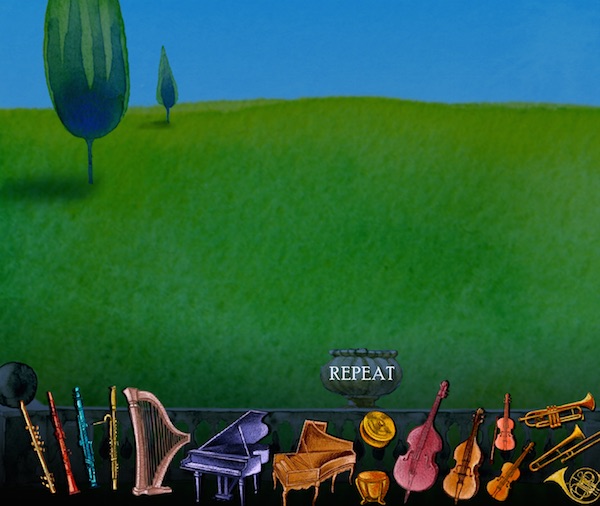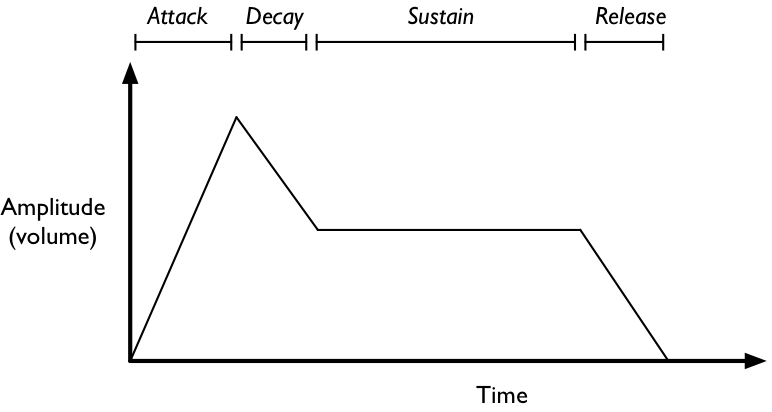The terms tone, timbre, and texture, all refer to how music sounds, and are sometimes used interchangeably. However as we tease out distinct definitions for each term, we will begin to hear so much more in every piece of music we encounter.
Take the next step and apply the principles of active listening to each one of the “Three T’s” and new musical vistas will unfold before your very ears!
Tone
Tone is one of the most widely used terms in music. It can refer to a specific type of interval, the space between two adjacent notes: “whole tone” is synonymous with “whole step” or “major second”. It can mean the notes themselves, as in “a melody is a series of tones”. Or it can mean the general sound of an instrument, more properly referred to as “timbre” – for example “How to develop a great guitar tone”.
For our purposes, and in alignment with contemporary audio conception, we will narrow down tone to mean the overall blend of frequencies present in a sound, also known as EQ.
“Pure” sounds, consisting of a single sound wave vibrating at a single frequency are extremely rare in the real world. Most sounds we hear, even those which sound “simple”, actually consist of a complex recipe of many sound waves vibrating at a wide range of frequencies.
The sound waves for a musical sound normally have a particular relationship called “harmonic”, which means the higher frequency waves are at multiples of the lowest “fundamental” frequency. For a certain fundamental frequency it’s the relative strength of the harmonics which determine the tone of the sound. This is how two sounds can have the same pitch (i.e. be the same musical note) but quite different tone.
 The simplest application of this concept is the tone knob that appears on electric guitars and basses. Turning the knob one way concentrates the energy in the higher frequencies and cuts out the lower frequencies, producing a “trebley” tone.
The simplest application of this concept is the tone knob that appears on electric guitars and basses. Turning the knob one way concentrates the energy in the higher frequencies and cuts out the lower frequencies, producing a “trebley” tone.
The bass guitar is an instrument which you might assume would always have a “bassy” tone. Not so! Here’s an example of a bass guitar riff with the tone knob being turned gradually to a more “treble” tone:
Conversely, turning the knob the other way has the opposite effect and produces a “bassy” tone:
Despite the difference in tone, both these examples are considered to be the same pitch, since they share the same fundamental.
 Audio engineers make heavy use of equalizers, or “EQ’s” to control the tone of individual instruments, of whole ensembles, and/or of sections of ensembles. They depend on their ability to hear and distinguish fundamental and harmonic frequencies, which can be developed through frequency ear training.
Audio engineers make heavy use of equalizers, or “EQ’s” to control the tone of individual instruments, of whole ensembles, and/or of sections of ensembles. They depend on their ability to hear and distinguish fundamental and harmonic frequencies, which can be developed through frequency ear training.
Now that you know the definition for tone you can use your active listening skills to identify “trebley” and “bassy” tones in a particular piece of music. Often a certain instrument in a song will have a particular tone throughout—for example you can listen for trebley guitars contrasting with low broad bassy synthesisers—but you might also hear how a certain instrument changes tone between sections of a song or for effect during a solo.
Timbre
Timbre (usually pronounced “tam’-ber” as in the first part of “tambourine”) is what makes one instrument or voice sound different than another. Timbre allows you to hear a musical note and know what instrument played it. This sounds simple but timbre actually incorporates a number of factors, including tone as discussed above. Researchers have actually identified dozens of factors that play into how we distinguish different sounds. It’s quite remarkable that the human ear and brain can hear a violin note and instantly know it’s a violin, considering how complex timbre actually is!
For example, try this fun instrument identification game from musicgames.net, based on timbre:
While it is possible to apply the term “timbre” to an overall sound, such as discussing the timbre of a song or track, it is best to keep it focused on individual instruments and voices.
One factor influencing the timbre of an instrument is how each note starts and stops. Some instruments have a gentle smooth shape to the notes, while others have a sharp, punchy, precise onset and release. This can be characterised using the “Attack Sustain Decay Release” envelope which shows the overall shape of a note:
Other factors include the overall frequency balance of a sound (related to tone) and how this varies over the duration of a note, how the pitch of a note fluctuates or stays steady, the presence of “noisy” sounds compared with “tonal” sounds, and much more.
As a practicing musician you don’t need to worry too much about the specific factors which determine timbre, but learning a bit about them can help you hear musical timbre in a more precise and sophisticated way.
The better you get to know timbre, the easier it becomes to pick apart the different instruments in a mixed track and appreciate the contribution made by each. Naturally this is doubly useful for the aspiring song writer, composer or audio engineer! For example it can help you identify suitable synthesisers for a track or (combined with EQ) fix a mix which sounds “muddy”. Composers and arrangers must factor timbre when arranging songs or orchestrating jazz standards.
Texture
Texture can refer to two related elements:
- The overall sound of an ensemble, including instrumentation and orchestration. Words like “thick”, “muddy”, “sparse” etc. can be used when talking about a track’s texture
- How the different streams of sound in a piece of music relate and interact. Words like “monophonic”, “homophonic” and “polyphonic” are used when talking about this kind of texture.
The first definition is a loose and informal one, often used in the studio or by audio professionals. It essentially boils down to the overall timbre of a track as a whole.
The second definition is the more traditional “classical” term, and is a more useful meaning to sit alongside “tone” and “timbre”.

Learning to hear texture as the parallel streams of musical notes can be very revealing to the active listener. For example, you can simply read the following three definitions and immediately start to pay attention to the texture of music you listen to:
- Monophonic: A single unaccompanied melody, for example you humming to yourself, or a solo trumpet playing a fanfare.
- Homophonic: A melody with an accompaniment, for example most pop songs where the lead singer’s part is the most prominent and the band provides the “backing music”.
- Polyphonic: Multiple independent melodies happening simultaneously. Rare in modern music but very common in classical music (particularly the Renaissance and Baroque eras).
You can learn more about these types of texture at DaveConservatoire.org.
How to Hear Tone, Timbre and Texture
Now that you know the definitions of these three terms and how they relate to each other, start trying to listen out for tone, timbre and texture in all the music you play and hear each day.
Here are some questions you could ask yourself:
- Tone: What is the tone of each instrument present? Is there a blend of bassy instruments and trebley instruments to create a balanced overall sound, or does the track itself have a particular tone?
- Tone: Are there any instruments with extreme or surprising tone? For example, can you hear high notes with a bassy sound, or low notes with a trebley sound?
- Timbre: How many instruments are present and what are they? Can you hear how their timbres differ? Sometimes this is easy (e.g. guitar vs. piano) but it can be subtle (e.g. same-gender voices in a cappella music).
- Timbre: Do you think the combination of timbres chosen by the arranger works well? Do they match or contrast with each other? How does the timbre of each instrument relate to the musical role it plays?
- Texture: How many independent melodic streams can you hear? Is it monophony (solo melody), homophony (melody + accompaniment) or polyphony (multiple melodies)?
- Texture: Does the texture change during the track? For example, is it homophony but passing the melody from instrument to instrument? Or are there times when a secondary melody is introduced alongside the main melody and accompaniment?
- How do tone, timbre and texture each contribute to the distinctive sound of the track? Can you imagine how changing one of these would affect the musical impact of the track?
- Can you learn anything about tone, timbre or texture from this track to be applied in your own music-making?
These three concepts—timbre, texture and tone—are often confused or misunderstood. The definitions can vary depending on the musical context (e.g. rock recording studio vs. classical orchestra) but whatever terminology is used, it’s important to be clear yourself on these three concepts. Make sure you understand tone, timbre and texture, and make the effort to think about each of them as you practice active listening and develop your musicianship.
Learning to hear tone, timbre and texture can unlock new worlds of musical appreciation for you, and it’s easy to get started. These three concepts are powerful and universal. Challenge yourself to learn more about each of them and listen out for their roles whenever you hear music, and you will soon be an expert in the “three T’s”!









